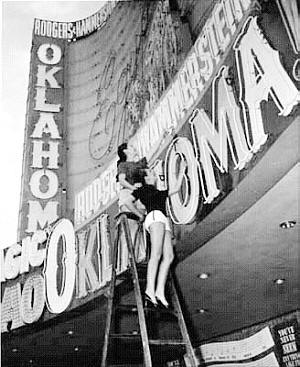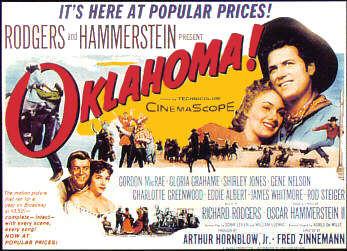|
|
|
|
|
|
|
|
|
|
|
|
70mm Film Finally Makes The Big Time
With Todd-AO
A full page ad appeared in LIFE magazine announcing the world premiere of Rodger's and Hammerstein's Oklahoma! and the new Todd-AO process featuring a NEW Sight! NEW Sound! NEW Screen! in Eastmancolor and Orthosonic Sound.

|
 See How the Rivoli Theatre was converted to Todd-AO |
 Article on Todd-AO projection at the Rivoli Theatre |

The new Todd-AO screen installed at the Hollywood Egyptian Theatre is big, just ask the ladies.
Courtesy of Robert C. Weisgerber

Off Broadway, ticket prices were still respectably high, and the seats, naturally, were reserved.
 |  |
 | The management of Grauman's Egyptian Theatre and Todd-AO fall back on the sort of advertising that has always worked for virtually every product known to man. It's not known for certain whether it is safer to work on a step ladder bare-footed or wearing high heels. Regardless, OSHA would probably get involved in this marquee promo nowadays. How many women does it take to change two lightbulbs? |
Joining Mike Todd, in his pre-Liz period, is Marlene Dietrich at the L.A. premiere of Oklahoma!. Dietrich will make a brief appearance the following year in the next Todd-AO production, Around the World in 80 Days. Dietrich did Todd-AO and Todd did Dietrich. To the left of Marlene Dietrich is the extremely attractive Donna Reed.
Photo courtesy of Robert Weisgerber


Todd-AO theatre illustration, ala Cinerama's.
The image was used for several films, with the screen contents changed as required. The picture on the right is the same diagram for the Portuguese premiere of Todd-AO and South Pacific, with the additional benefit of a colored theatre environment.
color photo courtesy of João Pereira Bastos, Lisbon.Despite continued publicity regarding the Todd-AO Mark III printer and its ability to produce the specially rectified prints, it was discovered during the premiere engagement of Oklahoma! that they really didn't work, and head on projection was nearly mandatory to get a decent image on the curved screen. - Another legend dies.
Seen above are two frames from Oklahoma! where the 127 degree bugeye lens was used. In all there were only about four brief shots in the film that used the amazing lens. Images captured from DVD
Oklahoma! proved to be a resounding success. Unfortunately, the 30 frame per second speed required that the film had to be photographed twice, first in Todd-AO and then in CinemaScope for general 35mm release.
The 35mm run of the film began as a quasi-roadshow affair distributed for Magna by RKO. Unfortunately, RKO was about to fold. For general release at "popular" prices, which always meant just a bit higher than normal, the film was handled by 20th Century-Fox. The difference in the artwork of the posters reflects that change in distribution.Left: RKO poster for Oklahoma!
Below: 20th Century-Fox poster for the same film.

The majority of the film going public, and all who saw Oklahoma! on television or video presentations, did not see the brilliant image of the Todd-AO process. What they saw was the CinemaScope version photographed in addition to Todd-AO. Because of the significant differences in the available optics for both systems, it was seldom possible to shoot in both processes at the same time. This required different camera setups and somewhat altered staging to produce the 35mm version. With the recent availability of the film on laser disc, transferred from the 30fps 65mm negative, most people agree that the Todd-AO version is superior in every way. In Todd-AO, it really was a beautiful morning. Note that the CinemaScope version ad shown here mentions that the film is in Technicolor. The Todd-AO prints carried no credit for color, but processing and printing was done by Consolidated Film Industries in Ft. Lee, New Jersey, the largest film lab in the world at that time, and print ads merely said Eastmancolor.
Possibly The Most Bizarre Product Tie-In Bread bags promoting Oklahoma! and announcing the upcoming addition of The Miracle of Todd-AO to the program at New York's Rivoli Theatre. The bags date back to 1955, the bread is fake designer stuff. The museum has some odd items on display but the bread bags are the strangest.
Approximagely six months after Oklahoma! began its premiere engagements, a featurette was added to the program. This film, titled The Miracle of Todd-AO, produced for Magna Theatres by Louis de Rochemont, was a demonstration of the system's Cinerama-like characteristics, which weren't well represented in Oklahoma!. The featurette was almost a condensed version of parts of This Is Cinerama and Cinerama Holiday.
It featured a roller coaster:
JOIN in the super-charged excitement of a roller coaster ride.
And this is Cinerama, er, Todd-AO:
FLY high through the majestic canyons of the Grand Teton Mountains.
And the Bug Eye lens hit the ski trails:
With skis on your feet (Where else?) you sweep through breath-taking slopes in Sun Valley, Idaho.
And with the co-operation of CHiPs:
CHILL your senses as you follow the thrill-packed police motorcycle chase over San Francisco's hills in
The Miracle of Todd-AO
Below is a frame from The Miracle of Todd-AO, the beginning of the roller coaster "test". Never Let The Truth Get In The Way Of A Good Story Though the audience was told that they were seeing documentary footage of the development and testing of Todd-AO, which was somehow also shot in Todd-AO, most of the equipment shown in The Miracle of Todd-AO didn't exist until after Oklahoma! was completed. Case in point: the bugeye lens seen in this frame is the small version that seems to have only been used in the making of the "documentary". When Mike Todd put Around the World in 80 Days in front of the cameras, he used only the original large versions.
Film frames courtesy of Jim Kroeper - Epic Proportions Inc.
Photo by crack theatre photographer Matt Lutthans
















E-mail the author
CLICK HERE
©1996 - 2004 The American WideScreen Museum
http://www.widescreenmuseum.com
Martin Hart, Curator









